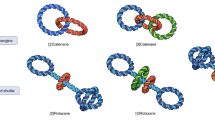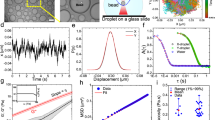Abstract
Folding is a ubiquitous process that nature uses to control the conformations of its molecular machines, allowing them to perform chemical and mechanical tasks. Over the years, chemists have synthesized foldamers that adopt well-defined and stable folded architectures, mimicking the control expressed by natural systems1,2. Mechanically interlocked molecules, such as rotaxanes and catenanes, are prototypical molecular machines that enable the controlled movement and positioning of their component parts3,4,5. Recently, combining the exquisite complexity of these two classes of molecules, donor–acceptor oligorotaxane foldamers have been synthesized, in which interactions between the mechanically interlocked component parts dictate the single-molecule assembly into a folded secondary structure6,7,8. Here we report on the mechanochemical properties of these molecules. We use atomic force microscopy-based single-molecule force spectroscopy to mechanically unfold oligorotaxanes, made of oligomeric dumbbells incorporating 1,5-dioxynaphthalene units encircled by cyclobis(paraquat-p-phenylene) rings. Real-time capture of fluctuations between unfolded and folded states reveals that the molecules exert forces of up to 50 pN against a mechanical load of up to 150 pN, and displays transition times of less than 10 μs. While the folding is at least as fast as that observed in proteins, it is remarkably more robust, thanks to the mechanically interlocked structure. Our results show that synthetic oligorotaxanes have the potential to exceed the performance of natural folding proteins.
This is a preview of subscription content, access via your institution
Access options
Access Nature and 54 other Nature Portfolio journals
Get Nature+, our best-value online-access subscription
$29.99 / 30 days
cancel any time
Subscribe to this journal
Receive 12 print issues and online access
$259.00 per year
only $21.58 per issue
Buy this article
- Purchase on Springer Link
- Instant access to full article PDF
Prices may be subject to local taxes which are calculated during checkout




Similar content being viewed by others
References
Guichard, G. & Huc, I. Synthetic foldamers. Chem. Commun. 47, 5933–5941 (2011).
Le Bailly, B. A. F. & Clayden, J. Dynamic foldamer chemistry. Chem. Commun. 52, 4852–4863 (2016).
Bruns, C. J. & Stoddart, J. F. The Nature of The Mechanical Bond: From Molecules to Machines (Wiley, Hoboken, NJ, 2017).
Erbas-Cakmak, S., Leigh, D. A., McTernan, C. T. & Nussbaumer, A. L. Artificial molecular machines. Chem. Rev. 115, 10081–10206 (2015).
Kay, E. R. & Leigh, D. A. Rise of the molecular machines. Angew. Chem. Int. Ed. 54, 10080–10088 (2015).
Basu, S. et al. Donor–acceptor oligorotaxanes made to order. Chem. Eur. J. 17, 2107–2119 (2011).
Zhu, Z. et al. Synthesis and solution-state dynamics of donor–acceptor oligorotaxane foldamers. Chem. Sci. 4, 1470–1483 (2013).
Bruns, C. J. & Stoddart, J. F. Mechanically interlaced and interlocked donor–acceptor foldamers. Adv. Polym. Sci. 261, 271–294 (2013).
Fisher, T. E., Marszalek, P. E. & Fernandez, J. M. Stretching single molecules into novel conformations using the atomic force microscope. Nat. Struct. Biol. 7, 719–724 (2000).
Bustamante, C., Chemla, Y. R., Forde, N. R. & Izhaky, D. Mechanical processes in biochemistry. Annu. Rev. Biochem. 73, 705–748 (2004).
Neuman, K. C. & Nagy, A. Single-molecule force spectroscopy: optical tweezers, magnetic tweezers and atomic force microscopy. Nat. Methods 5, 491–505 (2008).
Puchner, E. M. & Gaub, H. E. Force and function: probing proteins with AFM-based force spectroscopy. Curr. Opin. Struct. Biol. 19, 605–614 (2009).
Liang, J. & Fernandez, J. M. Mechanochemistry: one bond at a time. ACS Nano 3, 1628–1645 (2009).
Duwez, A.-S. & Willet, N. Molecular Manipulation with Atomic Force Microscopy (CRC Press, Boca Raton, 2012).
Hinterdorfer, P. & Dufrene, Y. F. Detection and localization of single molecular recognition events using atomic force microscopy. Nat. Methods 3, 347–355 (2006).
Müller, D. J. & Dufrêne, Y. F. Atomic force microscopy as a multifunctional molecular toolbox in nanobiotechnology. Nat. Nanotech. 3, 261–269 (2008).
Janke, M. et al. A. Mechanically interlocked calix[4]arene dimers display reversible bond breakage under force. Nat. Nanotech. 4, 225–229 (2009).
Lussis, P. et al. A single synthetic small molecule that generates force against a load. Nat. Nanotech. 6, 553–557 (2011).
Van Quaethem, A., Lussis, P., Leigh, D. A., Duwez, A.-S. & Fustin, C.-A. Probing the mobility of catenane rings in single molecules. Chem. Sci. 5, 1449–1452 (2014).
Odell, B. et al. Cyclobis(paraquat-p-phenylene). A tetracationic multipurpose receptor. Angew. Chem. Int. Ed. 27, 1547–1550 (1988).
Zhu, Z. et al. Oligomeric pseudorotaxanes adopting infinite-chain lattice superstructures. Angew. Chem. Int. Ed. 51, 7231–7235 (2012).
Franco, I., Schatz, G. C. & Ratner, M. A. Single-molecule pulling and the folding of donor–acceptor oligorotaxanes: phenomenology and interpretation. J. Chem. Phys. 131, 124902 (2009).
Hunter, C. A. Quantifying intermolecular interactions: guidelines for the molecular recognition toolbox. Angew. Chem. Int. Ed. 43, 5310–5324 (2004).
Beyer, M. K. & Clausen-Schaumann, H. Mechanochemistry: the mechanical activation of covalent bonds. Chem. Rev. 105, 2921–2948 (2005).
Flory, P. J. Statistical mechanics of chain molecules. Br. Polym. J. 2, 302–303 (1989).
Lee, G. et al. Nanospring behaviour of ankyrin repeats. Nature 440, 246–249 (2006).
Liphardt, J., Onoa, B., Smith, S. B., Tinoco, I. & Bustamante, C. Reversible unfolding of single RNA molecules by mechanical force. Science 292, 733–737 (2001).
Cecconi, C., Shank, E., Bustamante, C. & Marqusee, S. Direct observation of the three-state folding of a single protein molecule. Science 309, 2057–2060 (2005).
Junker, J. P. & Rief, M. Single-molecule force spectroscopy distinguishes target binding modes of calmodulin. Proc. Natl Acad. Sci. USA 106, 14361–14366 (2009).
Junker, J. P., Ziegler, F. & Rief, M. Ligand-dependent equilibrium fluctuations of single calmodulin molecules. Science 323, 633–637 (2009).
He, C. et al. Direct observation of the reversible two-state unfolding and refolding of an α/β protein by single-molecule atomic force microscopy. Angew. Chem. Int. Ed. 54, 9921–9925 (2015).
Žoldák, G., Stigler, J., Pelz, B., Li, H. & Rief, M. Ultrafast folding kinetics and cooperativity of villin headpiece in single-molecule force spectroscopy. Proc. Natl Acad. Sci. USA 110, 18156–18161 (2013).
Acknowledgements
D.S. thanks the Fonds de la Recherche Scientifique-Fonds National pour la Recherche Scientifique (FRS-FNRS) for his FRIA fellowship. The research was supported by the PDR T.0205.13 project of the FRS-FNRS at University of Liège and by the King Abdulaziz City of Science and Technology (KACST) as part of their Joint Center of Excellence in Integrated Nano-Systems (JCIN) at Northwestern University.
Author information
Authors and Affiliations
Contributions
D.S. and S.H. performed the AFM experiments and analysed the data. C.B. and Z.Z. carried out the oligorotaxane synthesis and characterization studies. A.-S.D. and J.F.S. designed the experiments. A.-S.D. and D.S. wrote the manuscript. All the authors discussed the results and commented on the manuscript.
Corresponding author
Ethics declarations
Competing interests
The authors declare no competing financial interests.
Additional information
Publisher’s note: Springer Nature remains neutral with regard to jurisdictional claims in published maps and institutional affiliations.
Supplementary information
Supplementary Information
Supplementary Figs. 1–5
Rights and permissions
About this article
Cite this article
Sluysmans, D., Hubert, S., Bruns, C.J. et al. Synthetic oligorotaxanes exert high forces when folding under mechanical load. Nature Nanotech 13, 209–213 (2018). https://doi.org/10.1038/s41565-017-0033-7
Received:
Accepted:
Published:
Issue Date:
DOI: https://doi.org/10.1038/s41565-017-0033-7
This article is cited by
-
Organic radicals in single-molecule junctions
Science China Materials (2024)
-
The many flavours of mechanochemistry and its plausible conceptual underpinnings
Nature Reviews Chemistry (2021)
-
From molecular to supramolecular electronics
Nature Reviews Materials (2021)
-
Radical-pairing-induced molecular assembly and motion
Nature Reviews Chemistry (2021)
-
Material properties and applications of mechanically interlocked polymers
Nature Reviews Materials (2021)



